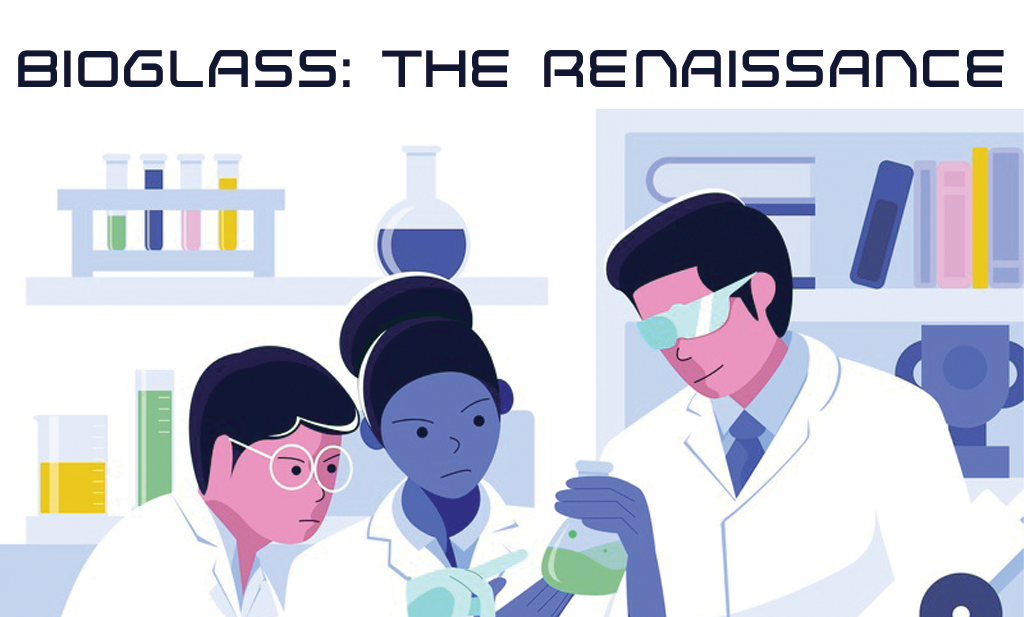Bioglass: the Renaissance in Medical Science

“Shards of glass can cut and wound or magnify a vision”, Terry Tempest Williams had written in her book, ‘Finding Beauty in a Broken World’ in 2008.
But almost fifty years ago, in the year 1969, scientist and children’s author, Larry Hench came up with the discovery of the 45S5 bioactive glass composition for use as a biomaterial which he rather funnily attributed to three miracles, a chance conversation, an award of funding despite him lacking a medical degree and a ‘fortunate’ selection of ‘just the right composition’.
Bioglass/ Bioactive Glass which would henceforth be referred to as BG in the article were the first synthetic material that could bond to living tissues in order to initiate their healing. Its discovery encouraged budding researchers to engineer different materials that could help the body build new organs or replace the damaged ones.
Potential of BG
Till date, glass products based on 45S5 composition have been successfully used in the repair of dental as well as bone defects since it could bond really well to the living tissues (existence of a great level of understanding, one must say) and further stimulate osteogenesis (the formation of bone). But its full potential hasn’t yet been fulfilled in the soft tissue repair applications (soft tissue includes muscles, tendons, ligaments, fascia, nerves, and fibrous tissue).
Different families of BGs are recently being studied in order to treat disorders of the soft tissues including that of myocardial infarction (heart attack in simple terms) which is the major cause of heart failure.
What brings BG into the picture?
Now we might think that what the need for bioactive glass is when a few natural polymers (like collagen matrix seeded with stem cells) are already extending amazing possibilities of cell therapy and have proved to be promising ways of creating a ‘bioartificial myocardium (simply, the heart muscle tissues)’.
The reason would be that inherent property of BGs which have been mentioned below support their use in soft tissue repair applications.
- Ability to bond well with soft tissues
- Ability to stimulate angiogenesis (growth of blood vessels from pre-existing ones)
- Antimicrobial effects
- Their excellent biocompatibility

Bioactive Glass in angiogenesis.
When impurities (like metal ions) are introduced into the BGs (doping) or BGs when used in conjunction with other materials (like polymers) can be effectively used to repair the damaged heart and lung tissues.
And most importantly, what if it proves to amaze us more as a biomaterial or we stumble upon some property that was never seen before? Materials rarely fail to surprise us in this aspect for sure.
Embracing the challenges
An aspect related to the use of BGs in contact with soft tissues that need to be addressed is the risk of deposition of calcium salts on the tissues (calcification) with which it is used. This happens mainly due to the peculiar property of BGs to form a layer known as hydroxyapatite at the junction of the tissue and the interface.
To provide a solution to this problem, fabrication of a Bioactive Glass-Polymer composite scaffold (scaffold is nothing but a structure providing support which aids cell growth) has been carried out with POSS (Polyhedral Oligomeric Silsesquioxanes)- PCU (Polycarbonate Urethane) such that calcification of lung tissues is curbed and better mechanical and surface properties of the scaffold can be obtained.
Other polymers/ proteins which could be used in place of POSS-PCU for the fabrication of the BG composites are:
- Metallic ion-doped polyurethane: Polyurethane doped with either ferric ions or magnesium ions as an alternative to POSS-PCU has been used.
- Fetuin-A: A wonder protein for the wonder material
Doping of BGs with small amounts of selected ions, e.g., Cu2+ has been seen to further improve the ability of the angiogenesis of BGs. Copper is also known to regulate several factors influencing angiogenesis.
A long Road Ahead!
BGs having a high volume to surface ratio cannot support cell survival for a long time as adequate food supply (oxygenation and nutrition) of the cells that it harbors becomes a problem. Thus it is extremely important to carry out interdisciplinary research in this field to overcome the challenge of limited survival of the engineered cells in the body and allow organ patterning (i.e., matching the 3D structure and topography of the lost tissue) so that the efficiency of BG as a biomaterial is greatly improved.

Microstructure of glass
And finally, as Larry Hench had said and the microstructure of glass to prompts,
References:
-
Francesco Baino, Sepideh Hamzehlou, and Saeid Kargozar; Bioactive Glasses: Where Are We and Where Are We Going? J Funct Biomater. 2018 Mar; 9(1): 25
-
Saeid Kargozar, Sepideh Hamzehlou, and Francesco Baino; Potential of Bioactive Glasses for Cardiac and Pulmonary Tissue Engineering, DOI: 10.3390/ma10121429
-
Eser Yuksel, M.D., Joshua Choo, Matthew Wettergreen, and Michael Liebschner, Ph.D.; Challenges in Soft Tissue Engineering. Semin Plast Surg. 2005 Aug; 19(3): 261–270
-
Bioactive glasses in soft tissue repair By Valentina Miguez-Pacheco, David Greenspan, Larry L. Hench, and Aldo R. Boccaccini
-
Jayarama Reddy Venugopal, Molamma P. Prabhakaran, Shayanti Mukherjee, Rajeswari Ravichandran, Kai Dan, and Seeram Ramakrishna; Biomaterial strategies for alleviation of myocardial infarction. J R Soc Interface. 2012 Jan 7; 9(66): 1–19
Note : Utmost care has been taken to credit the original authors/sources and to make these as apt as possible.


 Never miss a story, subscribe to our newsletter
Never miss a story, subscribe to our newsletter